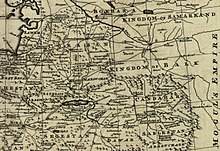Abdul Aziz Hotak
| Abdul Aziz Hotak عبد العزیز هوتک | |||||
|---|---|---|---|---|---|
Emir of Greater Kandahar | |||||
| Reign | Hotak Empire: 1715–1717 | ||||
| Coronation | 1715 | ||||
| Predecessor | Mirwais Hotak | ||||
| Successor | Mahmud Hotak | ||||
| Born | Kandahar | ||||
| Died | 1717 Kandahar | ||||
| |||||
| Dynasty | Hotak dynasty | ||||
| Father | Salim Khan | ||||
| Mother | Nazo Tokhi | ||||
| Religion | Sunni Islam | ||||
Shāh Abdul Azīz Hotak (Pashto/Dari: عبد العزیز هوتک; died 1717) was the second ruler of the Ghilji Hotak dynasty of Kandahar, in what is now the modern state of Afghanistan. He was crowned in 1715 after the death of his brother, Mirwais Hotak. He was the father of Ashraf Hotak, the fourth ruler of the Hotak dynasty. Abdul Aziz was killed in 1717 by his nephew Mahmud Hotak.
Early life
Abdul Aziz was born in a wealthy and politically connected family in the
Hajji Amanullah Hottak reports in his book that the Ghilji tribe were the original residents of

In 1707, Kandahar was in a state of chaos due to it being fought over for control by the
In 1709 Mirwais and Abdul Aziz began organising their countrymen in preparation for a major uprising. When a significant number of the Safavid garrison were on an expedition outside the city, followers of Mirwais and Abdul Aziz fell on the remainder and killed the greater number of them, including Gurgin Khan.[3]
The
Several half-hearted attempts to subdue the rebellious city having failed, the Persian Government despatched Khusraw Khán, nephew of the late Gurgín Khán, with an army of 30,000 men to effect its subjugation, but in spite of an initial success, which led the Afgháns to offer to surrender on terms, his uncompromising attitude impelled them to make a fresh desperate effort, resulting in the complete defeat of the Persian army (of whom only some 700 escaped) and the death of their general. Two years later, in 1713, another Persian army commanded by Rustam Khán was also defeated by the rebels, who thus secured possession of the whole province of Qandahár.[3]
, 1924
Death
Abdul Aziz sided with the Persians and re-entered the suzerainty of Safavid Iran, which proved unpopular with fellow Afghans. Mahmud Hotak, his nephew, seeing that his father, Mirwais Hotak's achievements would be washed away, assembled many of his fathers loyal followers, and entered the royal palace. Mahmud Hotak himself killed Abdul Aziz, and ascended the throne of the Hotaks at the age of 18.[5]
Abdul Aziz was buried at a mausoleum next to his brother in the Kokaran section of Kandahar City in Afghanistan.[6]
See also
References
- ^ "Mirwais Neeka". Archived from the original on 2007-04-09. Retrieved 2010-10-18.
- ^ ISBN 978-0-06-050508-0. Retrieved 2010-09-27.
- ^ a b c "AN OUTLINE OF THE HISTORY OF PERSIA DURING THE LAST TWO CENTURIES (A.D. 1722–1922)". Edward Granville Browne. London: Packard Humanities Institute. p. 29. Retrieved 2010-10-01.
- ISBN 978-0-8160-5056-7. Retrieved 2010-09-27.
- ^ Ali Maiwandi, Mohammed (1958). Afghanistan: The National Awakening. Punjab Educational Press. p. 15.
- )
